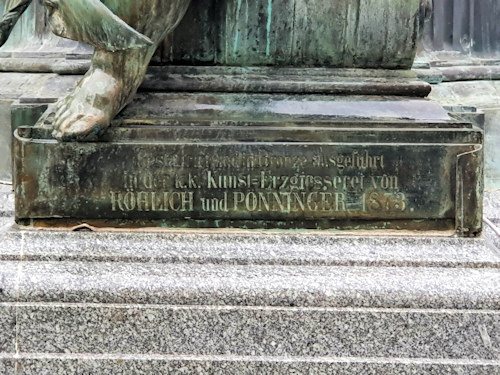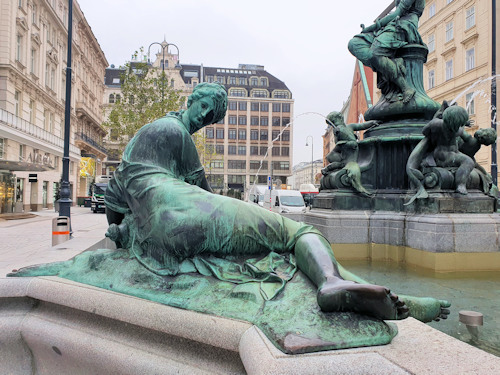
Drop into Neuer Markt square and your eye drifts naturally to the large fountain at the centre. Although overshadowed (figuratively and, sometimes, literally) by many nearby historical buildings, the Donnerbrunnen has its own claim to fame.
- Completed in 1739
- Figures are bronze copies from 1873
- Early example of secular public art
- See also:
18th-century fountain

(View of the fountain from the south)
Completed in 1739, the Donnerbrunnen was actually a municipal commission. Given the date, you might expect imperial reliefs or Christian motifs to dominate.
Not so.
This was possibly the first piece of such public art to forego the usual religious and Habsburgian imagery.
That novel secular approach perhaps reflected the growing self-confidence of the city authorities in an era of absolute monarchs. Though I can imagine there were one or two nervous faces at the unveiling.
(Apparently, that unveiling took place on the Emperor’s names day, which seems like a sensible way to placate any potential imperial ire.)
The Donnerbrunnen name comes from the sculptor who designed the fountain: Georg Raphael Donner (1693-1741). Another name you find used is the Providentiabrunnen, since the central figure is Providentia: the personification of the virtue of making provision for the future.

(The personification of the River Enns)
Other elements in Donner’s ensemble piece have river connections.
Below Providentia, for example, you find four putti handling various local fish species. And the four figures around the fountain’s edges personify tributaries of the Danube that would have run through the core Habsburg lands around Vienna: the March, Ybbs, Enns and Traun rivers.
Rivers make an obvious and common theme for fountains: see, for example, the Albrechtsbrunnen just up the road below the Albertina art museum or the Austriabrunnen on the Freyung.
The river figures on the Donnerbrunnen feel more varied than your typical watery statues, though.
Take the two men, for example. One elderly gentleman rests languidly with oar in hand, while a more youthful chap leans over the basin, trident poised to spear a fish below.

(The inscription notes that bronze restorations were carried out in 1873 by the foundry run by Josef Röhlich and Franz Pönninger)
Now, sharp-eyed observers will see the date 1873 inscribed on the fountain, which seems suspicious given the 18th-century origins.
Sadly, the lead-based statues designed by Donner proved a little too needy in terms of repair and maintenance.
As a result, bronze copies later replaced the sculptor’s figures. Fortunately, the latter can be seen in the permanent exhibition of the Wien Museum.
Experts consider those originals important works of mannerist art and far more animated than their 19th-century equivalents.
The square hosting the Donnerbrunnen sits right in the middle of Vienna, so various sights and attractions occupy the surrounds.

(Personification of the River Ybbs)
Two places of particular interest lie on Neuer Markt itself:
- The Capuchin church in the southwest corner with the Kapuzinergruft crypt. This provides a home for the mortal remains of dozens of emperors, empresses and their families. Inside, look, especially, for the Gothic horror-like decoration on the sarcophagus of Emperor Karl VI.
- The area has plenty of cafés and restaurants, but I have a soft spot for the Konditorei Oberlaa at the northwest corner of the square with its conservatory-like extension. I’ve always had fast and friendly service inside.
How to get there
Although embedded in the old town, Neuer Markt is easy to reach by public transport.
Subway: a short walk from Stephansplatz (U1 and U3 lines) or Karlsplatz (U1, U2 and U4) stations. At Karlsplatz, be sure to take the Oper exits, as it’s a big station.
Tram: also a short walk from the Oper/Karlsplatz stop on the 1, 2, D, 71, and 62 tram lines.
Address: Neuer Markt, 1010 Vienna